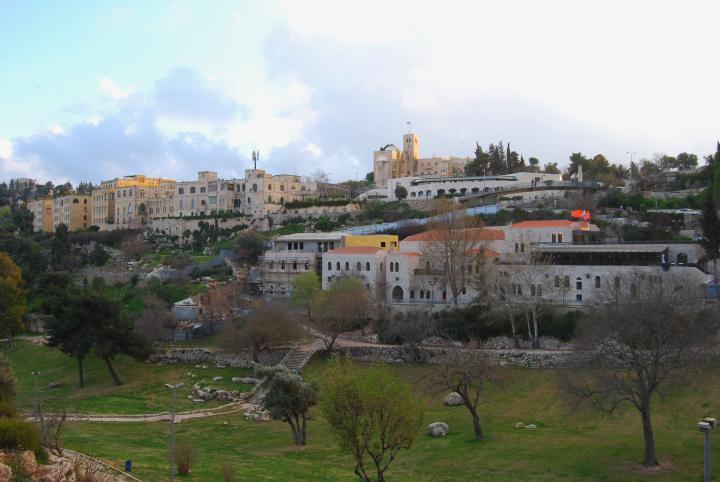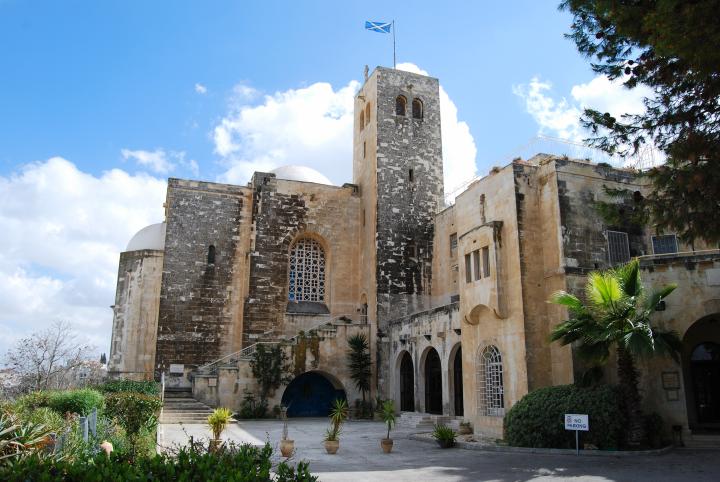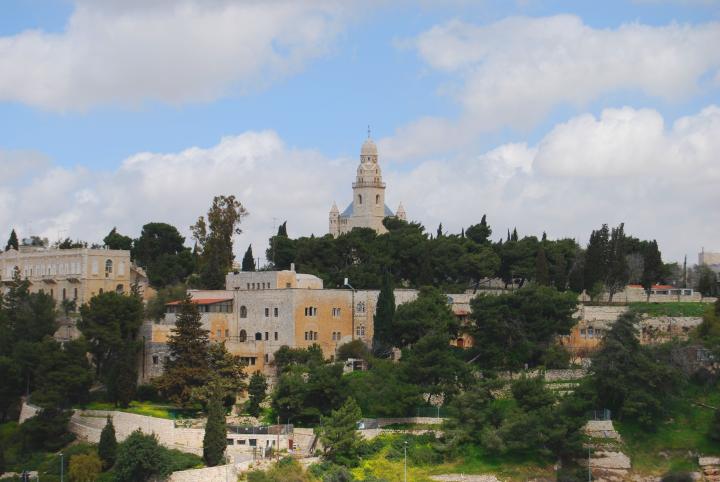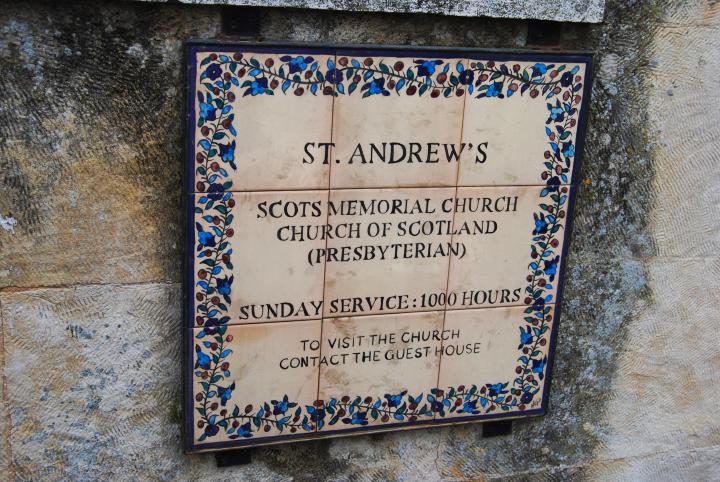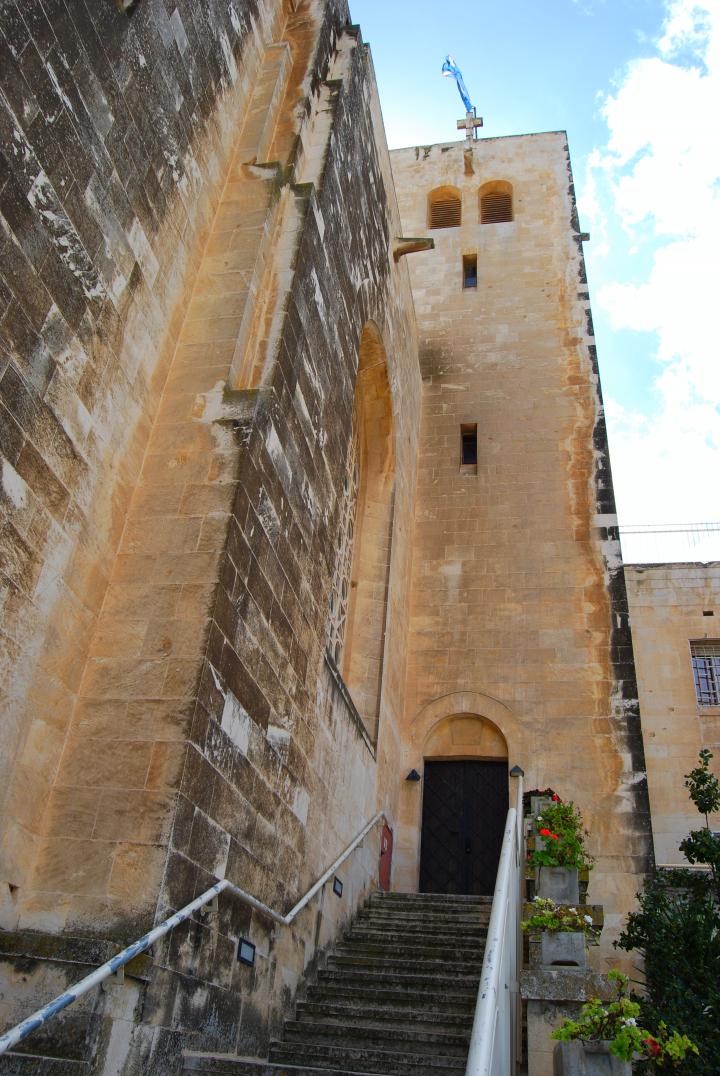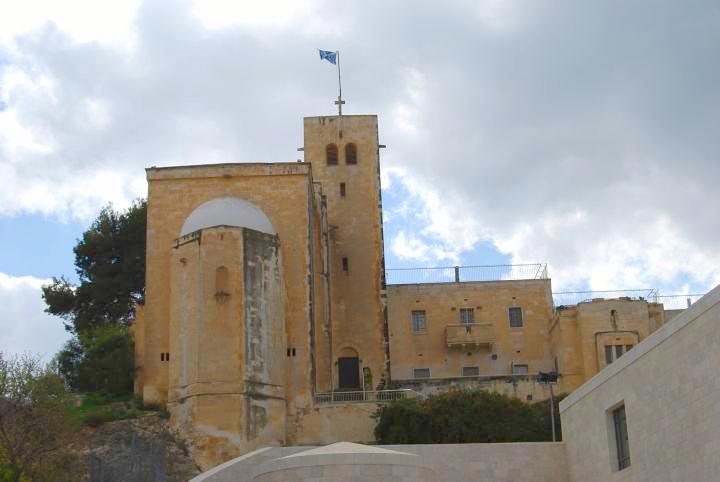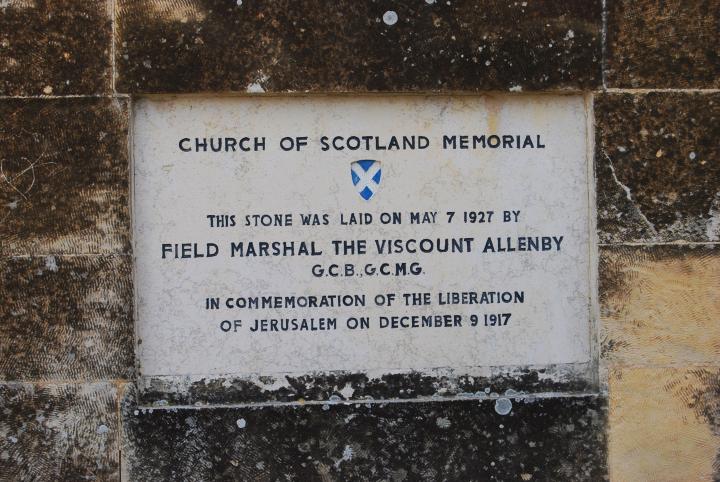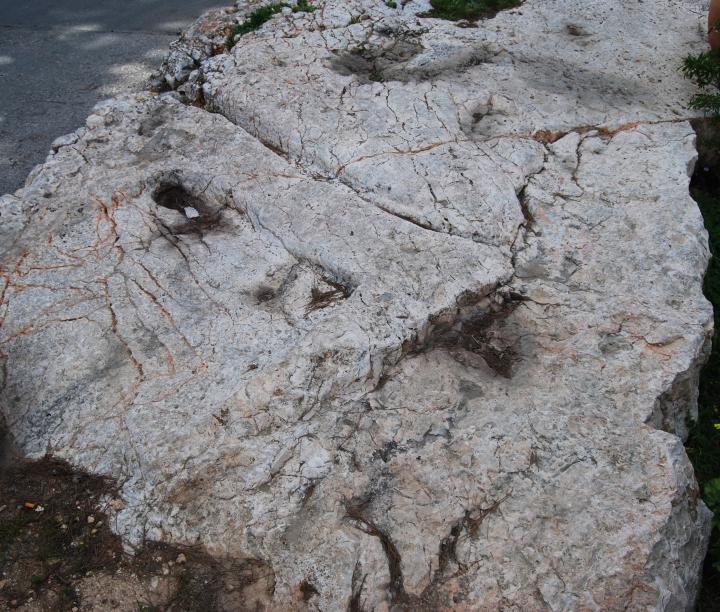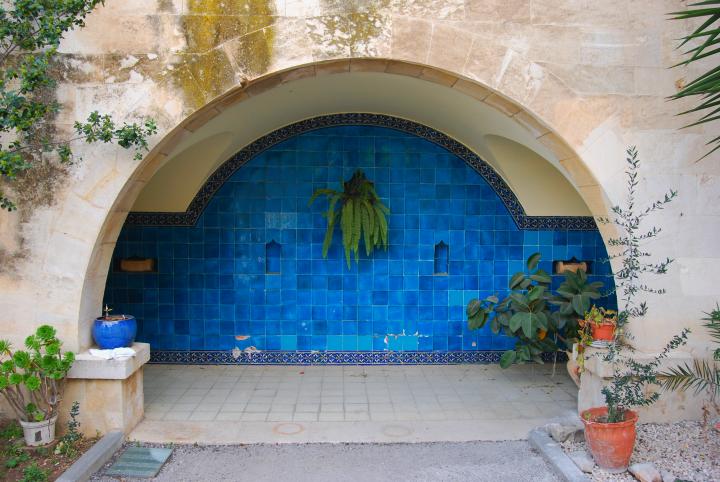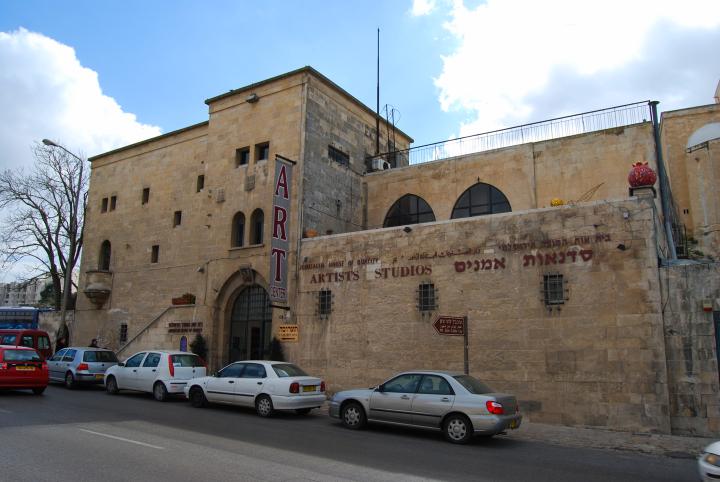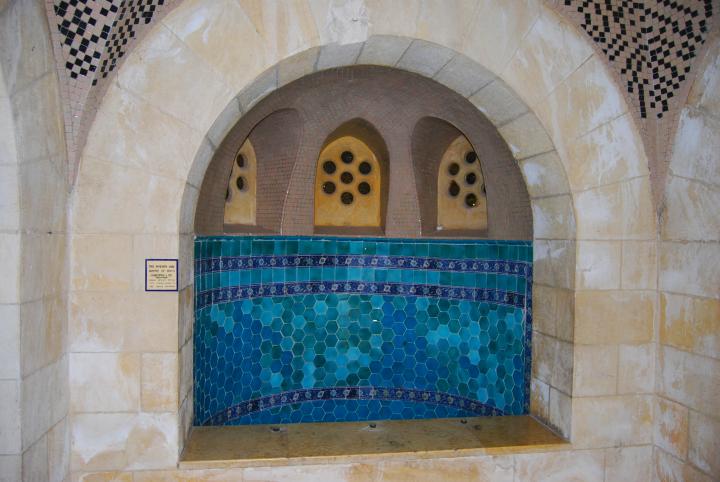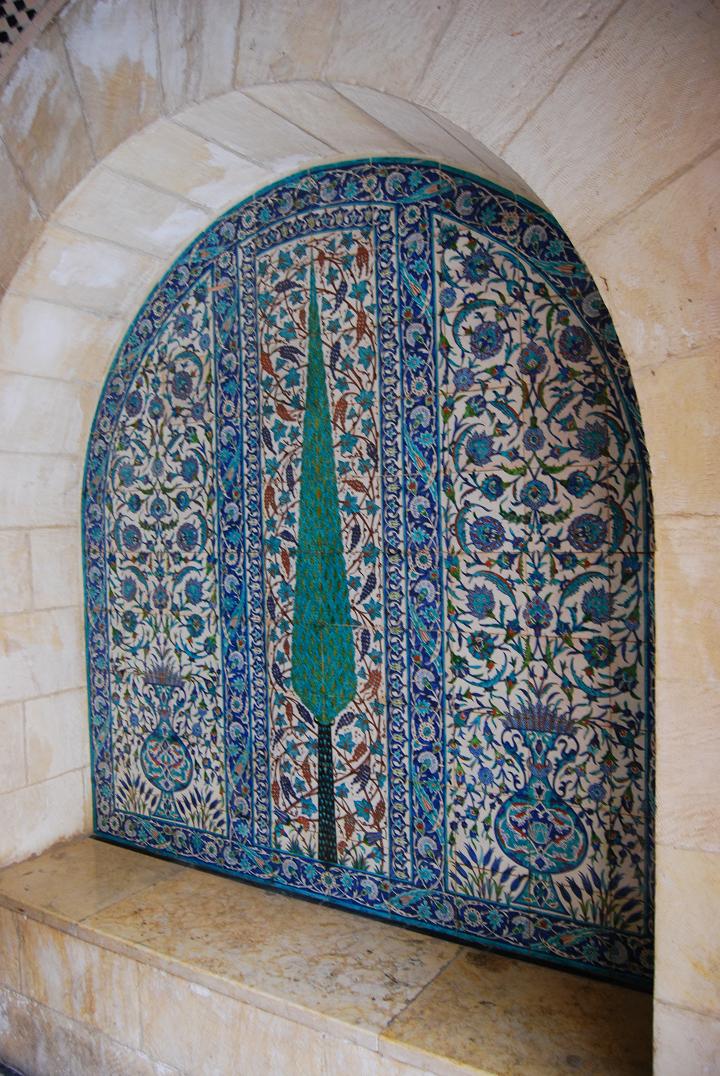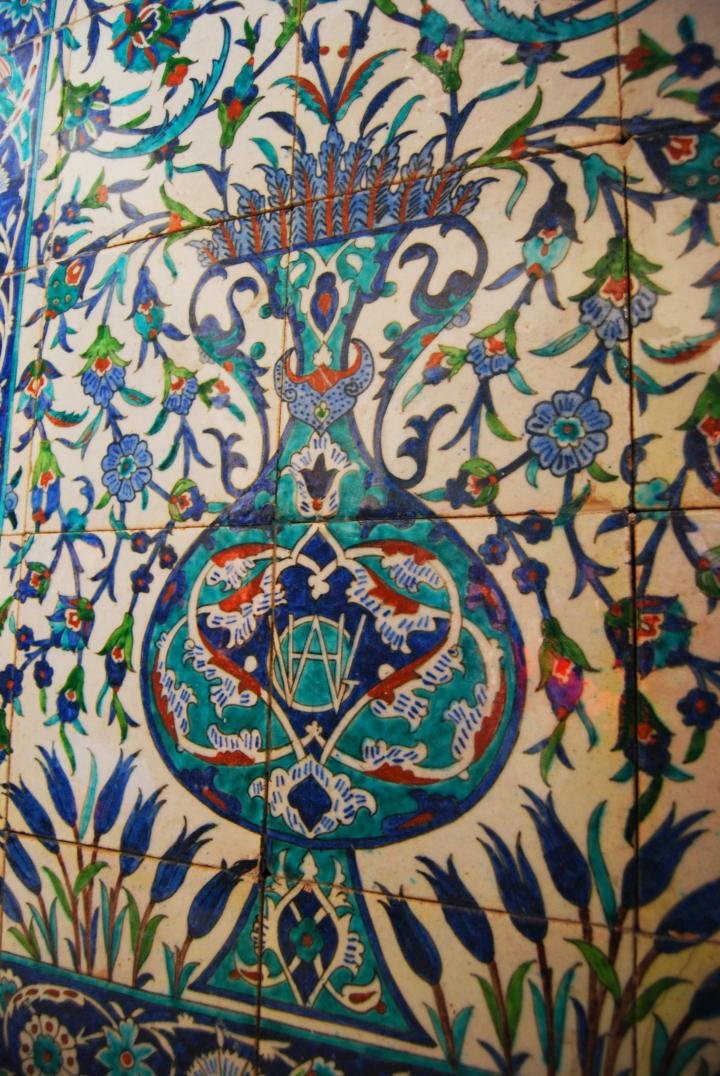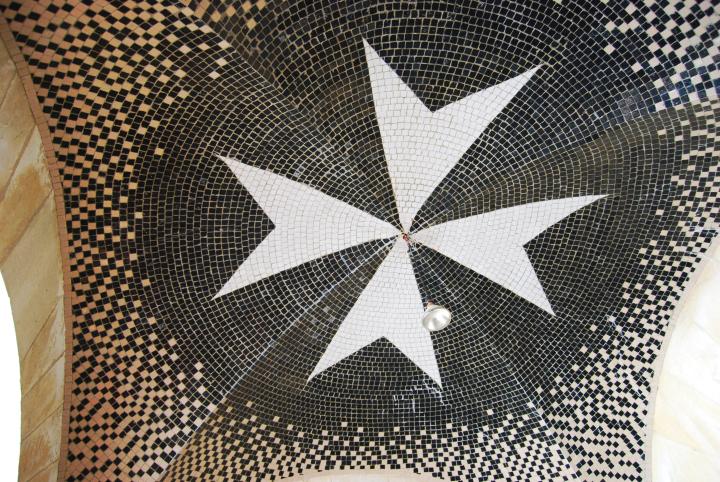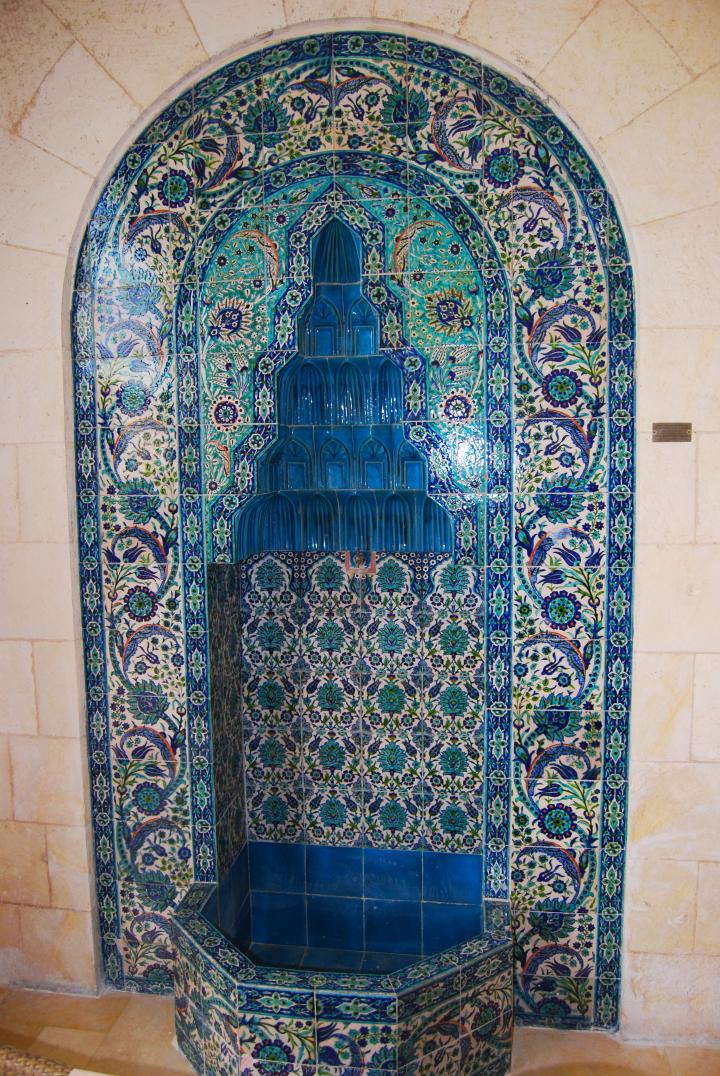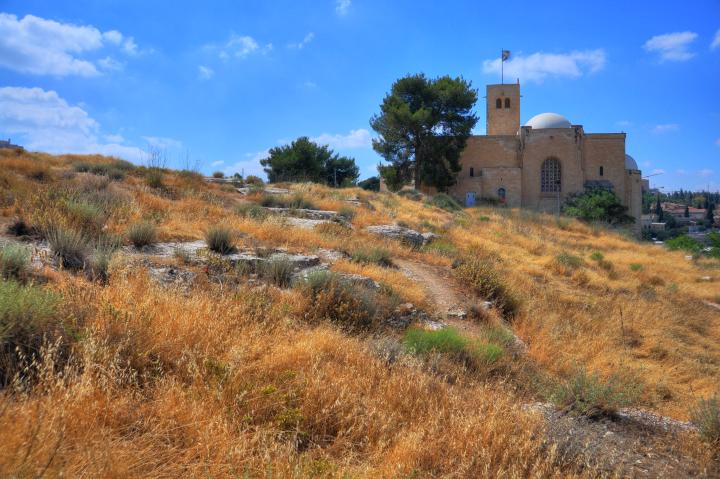A Scottish Protestant church and hospice, built in 1927 on a hill facing Mt Zion. Named after Andrews, one of Jesus’ twelve apostles, and a patron Saint of Scotland.
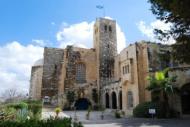
Home > Sites > Jerusalem > St. Andrew’s Scottish church
Contents:
Overview
Location
History
Photos
* General view
* Ancient sites
* Armenian tiles
* Hospital
* Bible Hill
Biblical Refs
Etymology
Links
Overview:
A Scottish Protestant church and guest house, located on a hill facing Mt Zion. Named after Andrews, one of Jesus’ twelve apostles, and a patron Saint of Scotland (and Russia). Andrews and his brother Peter were fishermen, natives of Bethsaida.
The church was built by the British as a memorial to the Scottish soldiers who fell fighting in this region during World War I.
Location:
St. Andrew’s is located on a hill south of Mt. Zion, on 1 David Remez Street. The son-of-Hinnom valley separates the two hills, as seen in the aerial map below. St. Andrew’s is close to the Jerusalem Khan theater and the Jerusalem railway station.
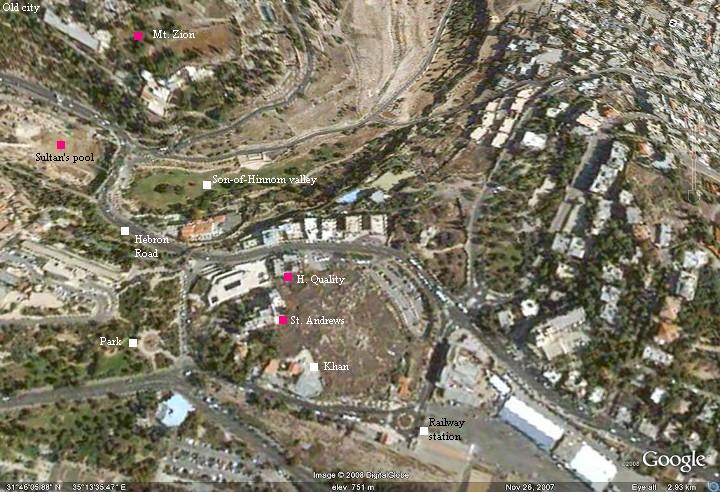
Thanks for Klaus Fesefeldt who corrected an error
History:
- Biblical period
During the first and second temple period this hillside was a Necropolis. Ancient tombs pocket the hillside north of the church and along the valley of son-of-Hinnom. On the north-east side under the church (an area called Ketef Hinnom), 9 burial caves were excavated, dating to Iron Age II (1000-595BC); they were in use until the Persian period (6-5th C BC). The burial continued here during the second temple period. A Roman tomb for the Legion X soldiers was also unearthed.
- Roman/Byzantine
Ruins of a Byzantine church are seen on the road leading to the church, which were excavated since 1975.
- Crusaders/Mamlukes
Before his death in 1329, the Scottish king – Robert the Bruce – wished that his heart be buried in Jerusalem. His wish was not fulfilled since the messenger was killed in Spain before arrival and the heart was buried there. However, after the church was built, a small copper plaque in the church floor commemorated the King.
- British mandate
The Scottish church was designed by Clifford Holliday and his Jerusalem colleagues Z. Hermit and D. Ben-Dor. It was built by the Scottish order of St. John.
The church was a memorial for the Scots who died in the region during WW1. The cornerstone ceremony of the church was held in 1927, and attended by Lord Allenby, the liberator of Jerusalem and the Holy Land.
A hospital was also constructed below the church. The hospital was a part of an ophthalmic hospital that served Jerusalem. The building was built in a Romantic style, combining the east and west architectures.
- Modern times
Since 1969 the hospital is used by Jerusalem’s craftsmen (and called “Jerusalem house of quality”). A public gallery is open to the public and displays works of Jerusalem artists.
Photos:
(a) General view:
St. Andrew’s church stands on a hill facing Mt Zion, across the valley of son-of-Hinnom. In the photo below the church is seen in the center part of the background.
Click on the photos to view in higher resolution…
A closer look on the church, as seen from the north-west side. The Scottish flag is seen above the square bell tower, with the blue and white colors and the St. Andrew’s “X” form cross.
The guest house is located on the first floor, on the right side of the court yard.
A panoramic view of Mt Zion and the south-west side of the old city can be seen from the church. The photo below shows the Dormition tower in the center of Mt Zion.
(b) Entrance:
A ceramic tile plate is located on the staircase wall.
The stairs lead to the church. The bell tower is seen above the entrance, with the Scottish flag and the cross on top of the roof.
A view from the north side, facing the old city. The Scottish flag is seen above the cross on top of the bell tower. The flag has blue and white colors with the St. Andrew’s cross (an “X” crux-decussata form cross; according to tradition Andrew was crucified on a cross of that form). Note that this “X” is also superimposed with two other crosses – England and Ireland – which form together the Union jack – Great Britton’s flag.
During WW1, on Dec 9, 1917, General Allenby liberated the city from the Turks after 730 years of Muslim control. A stone plate commemorates this important event. Lord Allenby inaugurated the building and the Scottish hospital in a cornerstone ceremony (May 7, 1927).
The symbol below the title is the Scottish “Saltire” symbol – blue and white colors and St. Andrew’s X-form cross.
(c) Ancient remains:
On the hillside (“Ketef Hinnom”) are first-temple tombs, Roman soldiers tomb, and ruins of a Byzantine church. These ruins are located beneath the access road below the church. Some of these rock cuttings can be seen along the access road, as seen in the photo below.
(d) Armenian decorations:
A pretty corner is located under the stairway, decorated with blue Armenian ceramic tiles. These glazed tiles are an original Jerusalem art, prepared by local Armenian craftsman in 1927. The art of the blue ceramics started in Jerusalem during the British mandate (1920-1948) when some of the churches were restored.
This art was based on a 15th C Turkish center in Iznik that produced tiles and ceramics for the Ottoman empire. The glazed ceramics were first was introduced to Jerusalem in the 16th C by when the Dome of the rock tiles were repaired by the Ottomans under Suleiman the Magnificent. The Iznik center, which assembled a number of craftsmen from the Turkish empire, decorated many of the major buildings throughout the countries it controlled. This center declined in the 17th C. It relocated to Kutahya, Turkey, in the 18th C. After WW1 the Armenian refugees, who came to Jerusalem and resettled in the Armenian section, imported the craftsmanship and several workshops were established. The British encouraged the use of the blue tiles in the city, and brought in master potters and artists, David Ohannessian and his disciples Nishan Balian and Megerdish Karakashian, who later opened their own workshops. These magnificent tiles can be seen in several buildings and churches and in the Armenian institutes.
(e) Scottish hospital – House of quality:
The building below the church was initially built as a Scottish hospital (St. John). The building was also inaugurated by Lord Allenby in 1927. Its two sections on both sides of Hebron road are linked by a tunnel. Since 1969 it is hosted by Jerusalem’s craftsmen and renamed ” The House of Quality”.
Inside the courtyard, on the western side, are magnificent decorations with Armenian blue ceramics, similar to the church’s stairway. The ceramics were created by the master David Ohanessian in 1925. These are seen in the photos below, inside the fountain niche.
Another amazing side of the fountain niche is seen below, with a cypress tree in the center and two vessels (amphorae) on both sides. Branches grow out of the vessels and fill up their background. Grapevines were incorporated into the background of the tree and into the frames.
A detail of the vessel on the right side is seen below. The monogram inside the medallion of the amphorae (“H-W-G”) is the initials of the family (Hunter-Weston) who financed the construction of the structure.
The ceiling is decorated with mosaic ceramics in a form of a cross.
A modern sebil (Turkish drinking fountain) is also beautifully decorated.
(f) Bible Hill:
A view from the east side of St James is shown below. This barren hill is called the “Bible Hill”, since it is identified as a Biblical landmark fn the border of the tribe of Judah (Joshua 15 8): “And the border went up by the valley of the son of Hinnom unto the south side of the Jebusite; the same is Jerusalem: and the border went up to the top of the mountain that lieth before the valley of Hinnom westward, which is at the end of the valley of the giants northward”.
The hill is located on the water divide: the rain drops to the Mediterranean (westward descent via valley of Rephaim) or to the Dead Sea (eastward descent via the valley of Hinnom and the Kidron stream).
Links:
Internal links:
Other Armenian Blue Ceramics sites:
- Armenian Church, Mount Zion – St. Saviour (the house of Caiaphas)
External links:
- St Andrew’s Scottish guest house
- Restorations of Jerusalem (needs pre-registration)
- Jerusalem archaeological survey (pdf, Hebrew): Ketef Hinnom
- David Ohannessian: Master of the Dome of the Rock Tiles Workshop 1919-1948 [Nirit Shalev Khalifa]
BibleWalks.com – walk with us through the sites of the Holy Land
Sultan’s pool<<<—previous Jerusalem site–<<< All Sites >>>—>>> Ein Karem
This page was last updated on Jan 26, 2012
Sponsored links:
